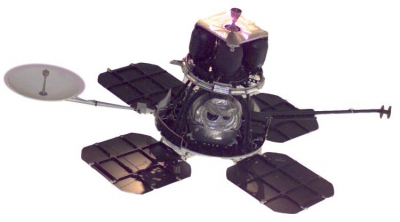The Lunar Orbiter 3 was a spacecraft launched by NASA in 1967 as part of the Lunar Orbiter Program. It was designed primarily to photograph areas of the lunar surface for confirmation of safe landing sites for the Surveyor and Apollo missions. It was also equipped to collect selenodetic, radiation intensity, and micrometeoroid impact data.
The spacecraft was placed in a cislunar trajectory and injected into an elliptical near-equatorial lunar orbit on February 8 at 21:54 UT. The orbit was 210.2 by 1,801.9 kilometres (130.6 mi 1,119.6 mi) with an inclination of 20.9 degrees and a period of 3 hours 25 minutes. After four days (25 orbits) of tracking the orbit was changed to 55 by 1,847 kilometres (34 mi 1,148 mi). The spacecraft acquired photographic data from February 15 to 23, 1967, and readout occurred through March 2, 1967. The film advance mechanism showed erratic behavior during this period resulting in a decision to begin readout of the frames earlier than planned. The frames were read out successfully until March 4 when the film advance motor burned out, leaving about 25% of the frames on the takeup reel, unable to be read.
A total of 149 medium resolution and 477 high resolution frames were returned. The frames were of excellent quality with resolution down to 1 metre (3 ft 3 in). Included was a frame of the Surveyor 1 landing site, permitting identification of the location of the spacecraft on the surface. Accurate data were acquired from all other experiments throughout the mission. The spacecraft was used for tracking purposes until it struck the lunar surface on command at 14.3 degrees N latitude, 97.7 degrees W longitude (selenographic coordinates) on October 9, 1967.
The Lunar Orbiter program was a series of five uncrewed lunar orbiter missions launched by the United States from 1966 through 1967. Intended to help select Apollo landing sites by mapping the Moon's surface, they provided the first photographs from lunar orbit and photographed both the Moon and Earth.
All five missions were successful, and 99 percent of the lunar surface was mapped from photographs taken with a resolution of 60 meters (200 ft) or better. The first three missions were dedicated to imaging 20 potential crewed lunar landing sites, selected based on Earth-based observations. These were flown at low-inclination orbits. The fourth and fifth missions were devoted to broader scientific objectives and were flown in high-altitude polar orbits. Lunar Orbiter 4 photographed the entire nearside and nine percent of the far side, and Lunar Orbiter 5 completed the far side coverage and acquired medium (20 m (66 ft)) and high (2 m (6 ft 7 in)) resolution images of 36 preselected areas. All of the Lunar Orbiter spacecraft were launched by Atlas-Agena-D launch vehicles.
The Lunar Orbiters had an ingenious imaging system, which consisted of a dual-lens camera, a film processing unit, a readout scanner, and a film handling apparatus. Both lenses, a 610 mm (24 in) narrow angle high resolution (HR) lens and an 80 mm (3.1 in) wide angle medium resolution (MR) lens, placed their frame exposures on a single roll of 70 mm film. The axes of the two cameras were coincident so the area imaged in the HR frames were centered within the MR frame areas. The film was moved during exposure to compensate for the spacecraft velocity, which was estimated by an electro-optical sensor. The film was then processed, scanned, and the images transmitted back to Earth.
During the Lunar Orbiter missions, the first pictures of Earth as a whole were taken, beginning with Earth-rise over the lunar surface by Lunar Orbiter 1 in August, 1966. The first full picture of the whole Earth was taken by Lunar Orbiter 5 on 8 August 1967. A second photo of the whole Earth was taken by Lunar Orbiter 5 on 10 November 1967.

1967Feb, 4
Lunar Orbiter program: Lunar Orbiter 3 lifts off from Cape Canaveral's Launch Complex 13 on its mission to identify possible landing sites for the Surveyor and Apollo spacecraft.
Choose Another Date
Events on 1967
- 15Jan
Green Bay Packers
The first Super Bowl is played in Los Angeles. The Green Bay Packers defeat the Kansas City Chiefs 35-10. - 28Apr
Muhammad Ali
Vietnam War: Boxer Muhammad Ali refuses his induction into the United States Army and is subsequently stripped of his championship and license. - 30May
Nigerian Civil War
The Nigerian Eastern Region declares independence as the Republic of Biafra, sparking a civil war. - 7Jun
Jerusalem
Six-Day War: Israeli soldiers enter Jerusalem. - 2Nov
Lyndon B. Johnson
Vietnam War: US President Lyndon B. Johnson and "The Wise Men" conclude that the American people should be given more optimistic reports on the progress of the war.

 English
English  español
español  français
français  português
português  русский
русский  العربية
العربية  简体中文
简体中文 